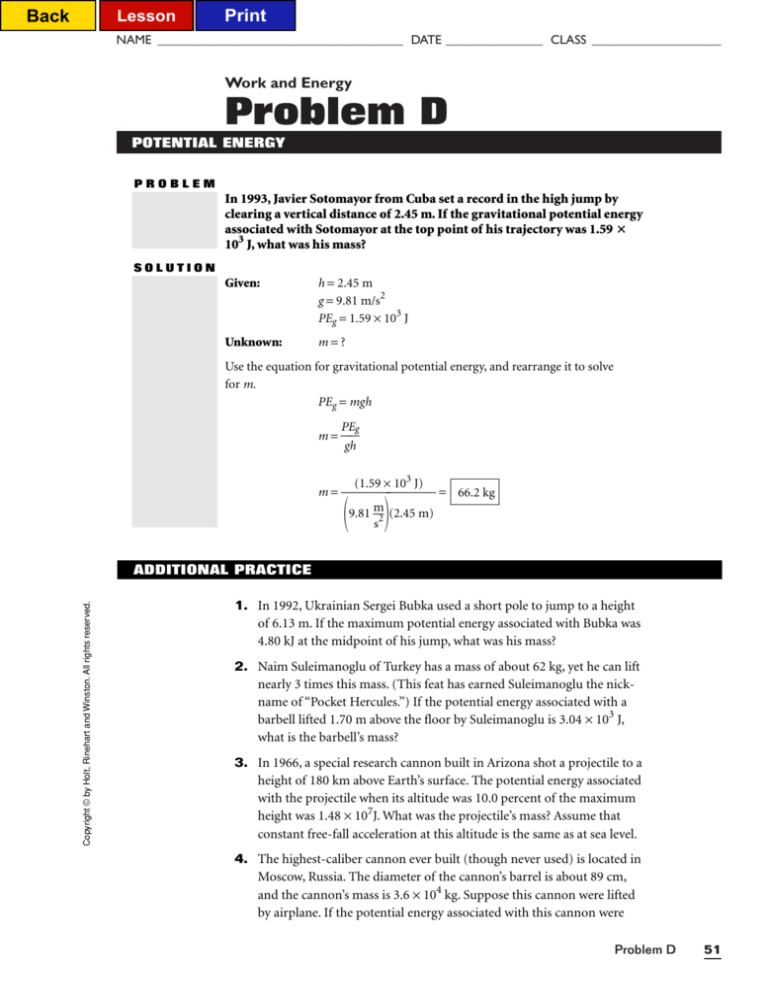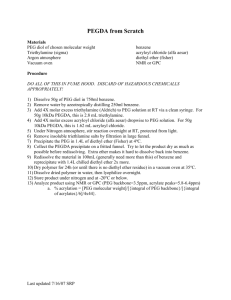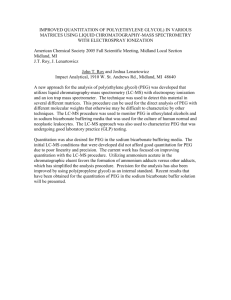
Back
Lesson
Print
NAME ______________________________________ DATE _______________ CLASS ____________________
Work and Energy
Problem D
POTENTIAL ENERGY
PROBLEM
In 1993, Javier Sotomayor from Cuba set a record in the high jump by
clearing a vertical distance of 2.45 m. If the gravitational potential energy
associated with Sotomayor at the top point of his trajectory was 1.59 103 J, what was his mass?
SOLUTION
Given:
h = 2.45 m
g = 9.81 m/s2
PEg = 1.59 × 103 J
Unknown:
m=?
Use the equation for gravitational potential energy, and rearrange it to solve
for m.
PEg = mgh
PEg
m =
gh
(1.59 × 103 J)
m = = 66.2 kg
2 (2.45 m)
9.81 m
s
s2
Copyright © by Holt, Rinehart and Winston. All rights reserved.
ADDITIONAL PRACTICE
1. In 1992, Ukrainian Sergei Bubka used a short pole to jump to a height
of 6.13 m. If the maximum potential energy associated with Bubka was
4.80 kJ at the midpoint of his jump, what was his mass?
2. Naim Suleimanoglu of Turkey has a mass of about 62 kg, yet he can lift
nearly 3 times this mass. (This feat has earned Suleimanoglu the nickname of “Pocket Hercules.”) If the potential energy associated with a
barbell lifted 1.70 m above the floor by Suleimanoglu is 3.04 × 103 J,
what is the barbell’s mass?
3. In 1966, a special research cannon built in Arizona shot a projectile to a
height of 180 km above Earth’s surface. The potential energy associated
with the projectile when its altitude was 10.0 percent of the maximum
height was 1.48 × 107J. What was the projectile’s mass? Assume that
constant free-fall acceleration at this altitude is the same as at sea level.
4. The highest-caliber cannon ever built (though never used) is located in
Moscow, Russia. The diameter of the cannon’s barrel is about 89 cm,
and the cannon’s mass is 3.6 × 104 kg. Suppose this cannon were lifted
by airplane. If the potential energy associated with this cannon were
Problem D
51
Back
Lesson
Print
NAME ______________________________________ DATE _______________ CLASS ____________________
8.88 × 108 J, what would be its height above sea level? Assume that
constant free-fall acceleration at this altitude is the same as at sea level.
5. In 1987, Stefka Kostadinova from Bulgaria set a new women’s record in
high jump. It is known that the ratio of the potential energy associated
with Kostadinova at the top of her jump to her mass was 20.482 m2/s2.
What was the height of her record jump?
6. In 1992, David Engwall of California used a slingshot to launch a dart
with a mass of 62 g. The dart traveled a horizontal distance of 477 m.
Suppose the slingshot had a spring constant of 3.0 × 104 N/m. If the
elastic potential energy stored in the slingshot just before the dart was
launched was 1.4 × 102 J, how far was the slingshot stretched?
7. Suppose a 51 kg bungee jumper steps off the Royal Gorge Bridge, in
Colorado. The bridge is situated 321 m above the Arkansas River. The
bungee cord’s spring constant is 32 N/m, the cord’s relaxed length is
104 m, and its length is 179 m when the jumper stops falling. What is
the total potential energy associated with the jumper at the end of his
fall? Assume that the bungee cord has negligible mass.
9. In 1872, a huge gold nugget with a mass of 286 kg was discovered in
Australia. The nugget was displayed for the public before it was melted
down to extract pure gold. Suppose this nugget is attached to the ceiling by a spring with a spring constant of 9.50 × 103 N/m. The nugget is
released from a height of 1.70 m above the floor, and is caught when it
is no longer moving downward and is about to be pulled back up by
the elastic force of the spring.
a. If the spring stretches a total amount of 59.0 cm, what is the elastic potential energy associated with the spring-nugget system?
b. What is the gravitational potential energy associated with the
nugget just before it is dropped?
c. What is the gravitational potential energy associated with the
nugget after the spring has stretched 59.0 cm?
d. What is the difference between the gravitational potential energy
values in parts (b) and (c)? How does this compare with your
answer for part (a)?
10. When April Moon set a record for flight shooting in 1981, the arrow
traveled a distance of 9.50 × 102 m. Suppose the arrow had a mass of
65.0 g, and that the angle at which the arrow was launched was 45.0°
above the horizontal.
a. What was the kinetic energy of the arrow at the instant it left
the bowstring?
52
Holt Physics Problem Workbook
Copyright © by Holt, Rinehart and Winston. All rights reserved.
8. Situated 4080 m above sea level, La Paz, Bolivia, is the highest capital in
the world. If a car with a mass of 905 kg is driven to La Paz from a location that is 1860 m above sea level, what is the increase in potential
energy?
Back
Lesson
Print
NAME ______________________________________ DATE _______________ CLASS ____________________
Copyright © by Holt, Rinehart and Winston. All rights reserved.
b. If the bowstring was pulled back 55.0 cm from its relaxed position, what was the spring constant of the bowstring? (Hint:
Assume that all of the elastic potential energy stored in the bowstring is converted to the arrow’s initial kinetic energy.)
c. Assuming that air resistance is negligible, determine the maximum height that the arrow reaches. (Hint: Equate the arrow’s initial kinetic energy to the sum of the maximum gravitational
potential energy associated with the arrow and the arrow’s kinetic
energy at maximum height.)
Problem D
53
Back
Print
Lesson
Givens
Solutions
Wr = m[2(vf 2 − vi2) − g(hi − hf)(cos q)] = (45.0 × 10−3 kg)2(27.0 m/s)2 − 2(0 m/s)2
1
1
1
−(9.81 m/s2)(8848.0 m − 8806.0 m)(cos 0°)
Wr = (45.0 × 10−3 kg)[364 m2/s2 − (9.81 m/s2)(42.0 m)]
Wr = (45.0 × 10−3 kg)(364 m2/s2 − 412 m2/s2)
Wr = (45.0 × 10−3 kg)(−48 m2/s2) = −2.16 J
6. vf = 35.0 m/s
vi = 25.0 m/s
Wnet = 21 kJ
1
1
Wnet = ∆KE = KEf − KEi = 2 mvf 2 − 2 mvi2
(2)(21 × 103 J)
42 × 103 J
2Wnet
m=
=
=
(35.0 m/s)2 − (25.0 m/s)2
1220 m2/s2 − 625 m2/s2
vf 2 − vi2
42 × 103 J
= 7.0 × 101 kg
m =
6.0 × 102 m2/s2
7. vi = 104.5 km/h
1
1
1
Wnet = ∆KE = KEf − KEi = 2mvf2 − 2mvi2
vf = 2vi
Wnet = Wkd(cos q) = Fkd(cos q) = mkmgd(cos q)
mk = 0.120
1
m(v 2
f
2
2
g = 9.81 m/s
q = 180°
− vi2) = mkmgd(cos q)
2
II
[(104.5 km/h)(103 m/km)(1 h/3600 s)]2[2 − (1)2]
d = =
(2)(0.120)(9.81 m/s2)(cos 180°)
2mkg(cos q)
1
2
vf − vi2
2
2
104.5
104.5
1
m/s 4 − 1
−(3) m/s
3.600
3.600
d =
=
−(2)(0.120)(9.81 m/s2)
−(8)(0.120)(9.81 m/s2)
d = 268 m
Additional Practice D
Copyright © by Holt, Rinehart and Winston. All rights reserved.
1. h = 6.13/2 m = 3.07 m
PEg = 4.80 kJ
PEg
4.80 × 103 J
m = = 2 = 1.59 × 102 kg
gh
(9.81 m/s )(3.07 m)
g = 9.81 m/s2
2. h = 1.70 m
PEg = 3.04 × 103 J
3.04 × 103 J
PEg
m = = 2 = 182 kg
(9.81 m/s )(1.70 m)
gh
g = 9.81 m/s2
3. PEg = 1.48 × 107 J
h = (0.100)(180 km)
1.48 × 107 J
PEg
m = =
= 83.8 kg
(9.81 m/s2)(0.100)(180 × 103 m)
gh
g = 9.81 m/s2
4. m = 3.6 × 104 kg
PEg = 8.88 × 108 J
8.88 × 108 J
PEg
h = =
= 2.5 × 103 m = 2.5 km
(3.6 × 104 kg)(9.81 m/s2)
mg
g = 9.81 m/s2
Section Two — Problem Workbook Solutions
II Ch. 5–5
Back
Print
Lesson
Givens
Solutions
PEg
5. = 20.482 m2/s2
m
g = 9.81 m/s2
20.482 m2/s2 20.482 m2/s2
h = =
= 2.09 m
g
9.81 m/s2
6. k = 3.0 × 104 N/m
2
PEelastic = 1.4 × 10 J
7. m = 51 kg
x=±
2P
Ek
= ± (
32.)0(1×.410×
1N0/mJ) = +9.7 × 10
2
elastic
4
−2
m = 9.7 cm
PEtot = PEg + PEelastic
2
g = 9.81 m/s
Set PEg = 0 J at the river level.
h = 321 m − 179 m = 142 m
PEg = mgh = (51 kg)(9.81 m/s2)(142 m) = 7.1 × 104 J
k = 32 N/m
PEelastic = 2 kx 2 = 2 (32 N/m)(75 m)2 = 9.0 × 104 J
x = 179 m − 104 m = 75 m
II
PEg
= gh = 20.482 m2/s2
m
8. h2 = 4080 m
h1 = 1860 m
1
1
PEtot = (7.1 × 104 J) + (9.0 × 104 J) = 1.6 × 105 J
∆PEg = PEg,2 − PEg,1 = mg(h2 − h1) = (905 kg)(9.81 m/s2)(4080 m − 1860 m)
∆PEg = (905 kg)(9.81 m/s2)(2220 m) = 1.97 × 107 J
m = 905 kg
g = 9.81 m/s2
9. m = 286 kg
1
1
a. PEelastic = 2 kx 2 = 2 (9.50 × 103 N/m)(0.590 m)2 = 1.65 × 103 J
k = 9.50 × 103 N/m
g = 9.81 m/s2
b. PEg,1 = mgh1 = (286 kg)(9.81 m/s2)(1.70 m) = 4.77 × 103 J
x = 59.0 cm
h2 = h1 − x
c. h2 = 1.70 m − 0.590 m = 1.11 m
PEg,2 = mgh2 = (286 kg)(9.81 m/s2)(1.11 m) = 3.11 × 103 J
d. ∆PEg = PEg,2 − PEg,1 = (3.11 × 103 J) − (4.77 × 103 J) = −1.66 × 103 J
The answer in part (d) is approximately equal in magnitude to that in (a); the
slight difference arises from rounding. The increase in elastic potential energy
corresponds to a decrease in gravitational potential energy; hence the difference
in signs for the two answers.
II Ch. 5–6
Holt Physics Solution Manual
Copyright © by Holt, Rinehart and Winston. All rights reserved.
h1 = 1.70 m








